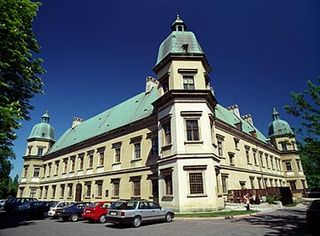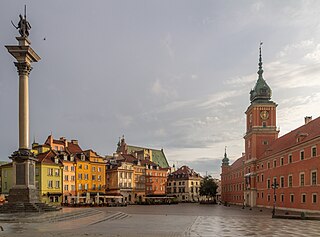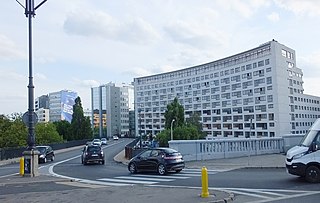
Zamość is a historical city in southeastern Poland. It is situated in the southern part of Lublin Voivodeship, about 90 km (56 mi) from Lublin, 247 km (153 mi) from Warsaw. In 2014, the population was 65,149.

Łowicz is a town in central Poland with 27,896 inhabitants (2020). It is situated in the Łódź Voivodeship ; previously, it was in Skierniewice Voivodeship (1975–1998). Together with a nearby station of Bednary, Łowicz is a major rail junction of central Poland, where the line from Warsaw splits into two directions - towards Poznań, and Łódź. Also, the station Łowicz Main is connected through a secondary-importance line with Skierniewice.

Ostrów Mazowiecka(listen) is a town in eastern Poland with 23,486 inhabitants (2004). Situated in the Masovian Voivodeship, previously in Ostrołęka Voivodeship (1975–1998). It is the capital of Ostrów Mazowiecka County.

The city of Warsaw, the capital of Poland, offers a variety of tourist attractions, including historical sights, monuments, museums, theatres, and places connected with Marie Curie, and with Frédéric Chopin and his music. Since 1980, the old town, one of the main attractions, has been a UNESCO World heritage site.

Ignacy Wyssogota Zakrzewski (1745–1802) was a notable Polish nobleman, politician, art collector, Freemason, and the Mayor of Warsaw during the last years of the Polish–Lithuanian Commonwealth, in 1792 and 1794.

Warsaw Old Town is the oldest part of Warsaw, the capital city of Poland. It is bounded by the Wybrzeże Gdańskie, along with the bank of the Vistula river, Grodzka, Mostowa and Podwale Streets. It is one of the most prominent tourist attractions in Warsaw. The heart of the area is the Old Town Market Place, rich in restaurants, cafés and shops. Surrounding streets feature medieval architecture such as the city walls, St. John's Cathedral and the Barbican which links the Old Town with Warsaw New Town.

The main square of the Old Town of Kraków, Lesser Poland, is the principal urban space located at the center of the city. It dates back to the 13th century, and at 3.79 ha is the largest medieval town square in Europe. The Project for Public Spaces (PPS) lists the square as the best public space in Europe due to its lively street life, and it was a major factor in the inclusion of Kraków as one of the top off-the-beaten-path destinations in the world in 2016.
Warsaw is the capital of Poland. This article gives an overview of street names in the city that refer to famous persons, cities or historic events.

St. Kazimierz Church is a Roman Catholic church in Warsaw's New Town at Rynek Nowego Miasta 2.

Żelechów(listen) is a town in east Poland in Masovian Voivodeship in Garwolin County. It is the seat of Gmina Żelechów. Żelechów is 85 kilometres from Warsaw and 85 kilometres far from Lublin. More than 4000 people live in the town. It is a local centre, supporting nearby farmers and housing a few high schools.

Stanisław Żaryn was an architect, urbanist, historian and academic teacher who significantly contributed to process of reconstruction of Polish historical architecture after its destruction by Germans during WW2. He was born in Warsaw to Eugenia and Franciszek Zaryn.

The Historical Museum of the City of Kraków in Kraków, Lesser Poland, was granted the status of an independent institution in 1945. Originally, it was a branch of the Old Records Office of Kraków, in operation from 1899.

Black procession was a demonstration held by burghers of Polish royal cities in Polish–Lithuanian Commonwealth's capital of Warsaw on 2 December 1789, during the Great Sejm. It vastly contributed to the passage of a belated major urban reform.

The Warsaw New Town is a neighborhood dating from the 15th century in Warsaw, Poland. It lies just north of the Old Town and is connected to it by ulica Freta, which begins at the Warsaw Barbican. Like the Old Town, the New Town was almost completely destroyed by the Germans during World War II and rebuilt after the war.

Poznań Old Town is the centermost neighbourhood of the city of Poznań in western Poland, covering the area of the once walled medieval city of Poznań. It is called Stare Miasto in Polish, although that name may also refer to the wider administrative district of Stare Miasto, which extends to most of the city centre and northern parts of the city.

New Town Market Place is the main square of the Warsaw New Town of Warsaw, Poland.

The Constitution of 3 May 1791 is an 1891 Romantic oil painting on canvas by the Polish artist Jan Matejko. It is a large piece, and one of Matejko's best known. It memorializes the Polish Constitution of 3 May 1791, a milestone in the history of the Polish–Lithuanian Commonwealth and a high point of the Polish Enlightenment.
The city walls of Warsaw are walls around Warsaw Old Town. They are composed of two lines: inner and outer, with several gates round the city. Originally raised between the 13th and 16th centuries, then rebuilt in 1950–1963, partly later. The best-preserved fragments of the fortification are those parallel to Podwale street, from the Warsaw Royal Castle to the Barbican Barbican and further to the Vistula Embankment.

Bydgoszcz Old Market square is an oblong place, situated in the old town district of the city of Bydgoszcz. The City Hall flanks one of its side, and nearby is located St. Martin and St. Nicholas Cathedral.

Solec is a neighbourhood along the Vistula river in Warsaw, the capital of Poland. It is situated east of Frascati on the southeastern edge of Downtown and south of the Powiśle suburb. Solec was a self governing settlement and town from 1675 until its incorporation into Warsaw in 1791. The name "Solec" is derived from the Polish word for salt – sól – which was extensively traded and transported through the neighbourhood since the late Middle Ages. However, contemporary Solec is mostly occupied by residential tower blocks and commercial buildings.




































